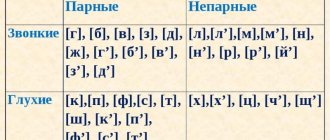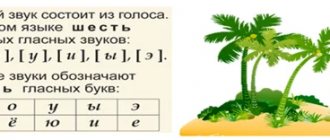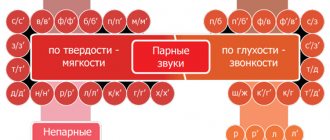- home
- Directories
- Handbook of Russian for elementary school
- Sounds and letters
- Consonant sounds and letters representing them
There are 21 consonant letters in the Russian language - B, V, G, D, ZH, Z, Y, K, L, M, N, P, R, S, T, F, Kh, Ts, Ch, Sh, Shch.
They represent 36 consonant sounds. Consonant sounds are dull and voiced, hard and soft. In transcription (phonetic notation), the softness of a consonant is indicated by the symbol - [ ' ].
Signs of consonants:
- A consonant sound consists of noise or noise and voice.
- When pronouncing a consonant sound, the air encounters an obstacle (lips, teeth, tongue).
- A consonant sound forms a syllable only together with a vowel sound.
Table of consonants and sounds:
| Letters | Sounds | |
| hard | soft | |
| bae | [b] lip [lip] | [b'] run [b'ek] |
| [p] tooth [zup] | [p'] fraction [drop'] | |
| ve | [in] ox [ox] | [v'] branch [v'etka] |
| [f] seam [shof] | [f'] eyebrow [brof] | |
| ge | [d] hammock [hammock] | [g'] weight [g'ir'a] |
| [k] threshold [vice] | [x'] easy [l'oh'k'iý] | |
| de | [d] gift [gift] | [d'] day [d'en'] |
| [t] boat [tray] | [t'] copper [m'et'] | |
| zhe | [f] toad [toad] | |
| th | [th'] my [my'] | |
| ka | [k] count [count] | [k'] sneakers [k'eds] |
| ale | [l] onion [onion] | [l'] modeling [l'epka] |
| Em | [m] mom [mom] | [m'] chalk [m'el] |
| en | [n] nose [nose] | [n'] song [p'esn'a] |
| pe | [p] log [pol'eno] | [p'] singing [p'en'ie] |
| er | [r] role [role'] | [r'] speech [r'ech'] |
| es | [s] salt [sol'] | [s'] hay [s'eno] |
| te | [t] chair [chair] | [t'] shadow [t'en'] |
| ef | [f] pheasant [pheasant] | [f'] coffee [coffee] |
| Ha | [x] ferret [ferret] | [x'] cunning [x'cunning'] |
| tse | [ts] circus [circus] | |
| what | [h'] teapot [ch'ay'n'ik] | |
| sha | [w] bump [bump] | |
| now | [sch'] pike [pike] | |
! Sometimes the letters h, sch are pronounced as the sound [sh] . This occurs in combinations schn, th, chn:
assistant [pamoshn'ik], that [what], of course [kan'eshna]
Share with friends on social networks:
Classification of consonants
By noise level:
| By noise level | |
| Sonorous | — voice predominates, noise level is insignificant - [l], [m], [n], [r], [th]; |
| Noisy | - significant noise level. Noisy ones are divided into:
|
| By hardness | |
| Solid | [l], [d], [s], [g], [ts], [w], etc. |
| Soft | [l,], [d,], [s,], [w,], [h,], [th], etc. |
Among the voiced consonants, there are 9 sounds in which there is more voice than noise. These are sonorant sounds.
Method of education
The method of formation of consonant sounds is understood as the method of overcoming an obstacle in the speech organs by an air stream. On this basis, the consonants of the Russian language are divided into:
- stop (explosive) . They are formed if the speech organs completely close in the path of the air stream. The air, meeting such a barrier, breaks through it sharply, with force. These are the sounds [b], [b'], [p], [p'], [g], [g'], [k], [k'], [d], [d'], [t] , [T'];
- fricatives (frictional) . When articulating them, the organs of speech do not close completely, but only come closer, and the air stream passes through the gap between them: [v], [v'], [f], [f'], [zh], [zh'], [ z], [z'], [s], [s'], [j], [w], [sh̄'], [x], [x'];
- affricates (stop-frictional) , the articulation of which takes place in two stages. At the first stage, the exhaled air overcomes the closed organs of speech. Further, unlike explosive sounds, the bow does not break immediately, but first passes into a gap through which the air stream continues to flow: [ts], [h'];
- closure-passage . When they are formed, a complete closure of the speech organs occurs, but the air not only breaks this closure, but also partially bypasses it - either through the nasal cavity ( nasal sounds [m], [m'], [n], [n']), or through the oral cavity on the sides of the barrier ( lateral consonants [l], [l']);
- trembling (vibrants) . When pronouncing them, the speech organs repeatedly close and open: [р], [р'].
Definition
Sonorant sounds are voiced consonant sounds in which the voice dominates the noise. The word “sonorous” comes from the Latin – “sonorous”, which translated into Russian means “sonorous”. The sonorant group includes eight paired softness-hardness ones and one soft unpaired one: [l] - [l'], [m] - [m'], [n] - [n'], [r] - [r '], [th].
Sonorous sounds, as a rule, are formed with the participation of the lungs, vocal cords, lips, tongue, and palate. Teeth are not involved in their formation. According to the place and method of formation, they are: labiolabial - [m], [m']; lingual-labial – [n], [n']; lingual-palatal – [l], [l'], [r], [r'], [th']. In terms of sound strength, they are all voiced.
Test on the topic
- /5
Question 1 of 5How many consonants are there in Russian?
Start test
Hall of Fame
To get here, take the test.
- Sergey Efremov
4/5
- Stepan Schwartz
5/5
- Elena Chernova
5/5
- Anastasia Petrova
5/5
Unpaired voiced sonorants
As noted above, all sonorants belong to voiced consonant sounds. Unlike most voiced consonants, sonorant sounds do not have voiceless pairs. If other consonants, such as [d], [d'], [b], [b'], [z], [z'] and others have paired voiceless [t], [t'], [p] , [p'], [s], [s'], then the sonorant sounds [l], [l'], [m], [m'], [n], [n'], [r], [ р'], [й'] do not have such a pair among voiceless consonants. All sonorant sounds according to this feature are unpaired. They are not deafened in any position: neither at the end of a word, nor before voiceless consonants. They are always pronounced loudly - with vocal force, and ordinary paired consonants at the end of a word and before voiceless consonants are pronounced dull.
This is easy to check by comparison:
"home": before
[m] – “frost”: moro [s]; “day”: de[n'] – “copper”: me[t']; “breakdown”: shelf[m]ka – boat: boat[t]ka; “slice”: do[l']ka – “radish”: re[t']ka.
- The consonants R, L, M, N, J are called sonorant.
- All only voiced, unpaired consonants help to remember the phrase:
LEMON IS PARADISE!
If you delete all the vowels in this sentence, then only voiced, unpaired consonant sounds will remain.
| Hard sonorous sounds | Sonorant sounds, with the exception of the sound [th'], have a pair of hardness: [l] - [l'], [m] - [m'], [n] - [n'], [r] - [r' ]. In certain positions they can be pronounced both softly and firmly: “elk”: [l]os – “salt”: so[l']; “mol”: [m]mol – “mel”: [m']mel; “bottom”: d[n]o – “day”: de[n’], “lynx”: [r]lyx – “door”: two[r’]. The sound [y'] is not pronounced firmly under any circumstances, and does not have a hardness pair: “egg” - [y'ay'tso]. It's just soft. In its sound, it is the closest of the sonorant sounds to vowel sounds, especially close to - [and]. Sometimes it is even called “and - short” |
| Voiced sonorant consonants | All sonorant sounds are only voiced sounds, there are no dull sounds among them!!! |
| Voiceless sonorous sounds | There are no dull sounds among sonorants!!! |
| Hissing sonorous sounds | There are no hissing sonorous sounds!!! |
Place of education
When pronouncing consonant sounds, a barrier is formed in the speech organs, which is overcome by the air stream exhaled from the lungs. This obstacle occurs with the participation of an active, i.e. moving, organ of speech (tongue or lower lip) and a passive, i.e. fixed or sedentary organ (upper lip, teeth, alveoli, hard or soft palate).
According to the active organ, all consonants are divided into labial and lingual . Among the latter, they are divided into front-lingual, middle-lingual and posterior-lingual , depending on which part of the tongue plays the main role in articulation.
If we also take into account passive organs, we can construct a more detailed classification.
Thus, labial consonants are divided into two groups:
- labial-labial , when pronounced, the lower and upper lips close: [b], [b'], [p], [p'], [m], [m'];
- labiodental , which are formed by bringing the lower lip and upper teeth together: [v], [v'], [f], [f'].
Linguistic consonants are:
- anterior lingual dental , when the tip of the tongue closes or approaches the upper teeth: [d], [d'], [t], [t'], [s], [s'], [z], [z'], [ l], [l'], [n], [n'], [ts];
- anterior lingual palatodental (alveolar) , during the formation of which the front part of the tongue rises to the alveoli - the tubercles between the front upper teeth and the palate: [р], [р'], [ш], [ж], [ш̄'], [ж̄ '], [h'];
- midlingual midpalatal , in the articulation of which the middle part of the tongue is involved, moving closer to the middle part of the palate: [j];
- posterior lingual posterior palatal , formed by the interaction of the back of the tongue with the posterior palate: [g], [g'], [k], [k'], [x], [x'].
Let's remember
Now let's move on to methods of studying and memorizing. 1st grade remembers hard consonants reluctantly - it’s too boring. But there is always a way to increase efficiency by getting the student interested in an unusual form of work, even with material that is so theoretical and unnecessary, at first glance. Various pictures, diagrams, drawings and games with word choice will come to our aid.
Let's make cards, perhaps. You will need two sheets of colored paper or colored cardboard. The main thing is that they are contrasting. We cut out identical clouds, balls, figures - whatever comes to your mind. Then we connect the two figures with glue so that these very contrasting sides are on the outside. And then, with the participation of your little assistant, on one side we write vowels that are friendly with soft consonants, and on the other - with hard consonants. In order not to forget anything at all, you can also place unpaired and paired ones next to each other, respectively. When everything is at hand, it is much easier.
Next, we draw something that can help create an association - a brick on cardboard with hard sounds written on it, and a feather with soft phonemes. Or something else like that. Having a concrete example before his eyes, the student will certainly learn the information better. Later, for reinforcement, you can ask your student to highlight hard and soft sounds in written words in different colors - red and blue, for example, so that you can easily check his homework.
Voiced and voiceless consonants
To understand what unpaired consonants are, we first determine that our speech consists of sentences, sentences of words, and words of sounds.
Sound is the minimum unit of speech, which in itself has no meaning, but when combined with other sounds it creates the phonetic appearance of a word that has a lexical meaning.
Speech sounds are pronounced in different ways. If a stream of air passes freely through tense vocal cords and the oral cavity, then the vowel sounds , , , , , are formed. Vowel sounds are formed entirely by the voice.
Most speech sounds are formed when the exhaled air encounters obstacles in the form of the tongue, teeth, closing and opening of lips, etc. Then a noisy sound appears, which is called a consonant.
Based on the relationship between voice and noise, consonant sounds are divided into voiced and voiceless.
Voiced consonants consist of noise and voice:
, , , , ,
Voiceless consonants, on the contrary, are “voiceless.” They consist only of noise:
, , , , , , , , ,
Many voiced and voiceless consonants are similar in their method of formation, but differ only in their sonority, that is, the participation of the voice, or deafness. Based on their voicedness/voicelessness, these consonants form pairs:
- —
- —
- —
- —
- —
- — .
These are paired consonants that differ in the sign of voicedness/voicelessness.
In the phonetics of the Russian language, there are 6 pairs of voiced and voiceless consonants. With their help you can distinguish words:
- dress - emphasis;
- moisture - flask;
- grotto - mole;
- firewood - grass:
- pity - prank;
- pharynx - sitting
The remaining consonants are unpaired.
Examples of tasks for children
Voiceless or voiced:
- A simple and vivid way that helps you understand the difference is to put your palm to your throat when pronouncing. Go through all the consonants, let the child discover which letter vibrates and which does not give sensations.
- Choose pictures that resemble ringing and deafness. For example: bell and ear. Say different words of one or two syllables, and if the child hears a ringing sound, he should show a picture with a bell. Then play the same way with a dull sound. When the child gets comfortable with simple words, take longer ones.
Hard or soft:
- Offer to take one letter and sing syllables with vowels that give hardness. Let the child feel the firmness in his voice. Then, with the same letter, sing syllables with vowels that give softness.
- Name the syllable and throw the ball to the child. If it's hard, you should catch it. If it's soft, push it away.
- Make a chain of words. For example, chair-horse-money-guitar...
General tasks:
- Create your own table with colorful images and hang it in a prominent place. When a child chooses a drawing or color himself, he becomes more involved in the topic and remembers it faster.
- Offer to name a word that has both a voiced and a voiceless word. Or deaf and, at the same time, hard.
Other types of consonants
There are a few more names that you need to remember to easily understand the rules.
Unpronounceable
Due to the peculiarities of pronunciation in our language, some consonants in words “fall out”: sun - [l], stairs - [t], hello - [v].
To check an unpronounceable sound, you need to choose a single-root word in which there will be a vowel after the dubious consonant or there will be no combination of several consonants. For example, we check “hello” with the word “health”, “sun” - “sunny”, “sun”.
Doubled
This is when two identical consonants are nearby. The most famous example is the double NN rule.
Words that have double consonants in the root are usually borrowed: ammonium, ton, kilogram.
Other consonant changes
For a list of consonant changes, see Phonetic Cheat Sheet
- Simplification of a consonant group of 3-4 letters (unpronounceable consonant): sun e [so nts e], reed stnik [tra s'n 'ik], heart [ s'er rts e], hello uy [health stv uy'], staircase [ l'e s'n'itsa ], etc.
- Assimilation (assimilation) of consonants according to the place of formation: happiness [ shch ' ast'y'e], gruzchik [ grushchik ], sew [ shyt '], compress [ zhat '], get rid of [and w: yt'], etc.
- Change - tsya, -tsya in verbs starting with [ tsa ]: wash tsya [my tsa ], wash tsya [moy'e tsa ], etc.
- Change th - [sht]/ [h't]: what about [shto], what usual [shtoby], not what about [not h't a], etc.
- Double consonants: va anna [va n: a], trass a [tra s: a], mill ll ion [m'i l' ion], etc.
Sounds can change according to several characteristics at once: counting [pach'sch'ot] – sch->[sch'], d+[sch']->[ch'sch'].
Characteristics of each sound
- [Р], [Р'] - trembling sounds, formed in connection with the touch of the tongue to the alveoli (hand - [hand], river - [r'eka]).
- [L], [L'] - sounds that are pronounced by passing an air flow through the tip of the tongue, precisely when touching the alveoli (lama - [lama], forest - [l'es]).
- [M], [M'] – sounds related to nasals. Indeed, during their formation, an air flow is passed through the nose, the upper and lower lips are connected in parallel, the lungs create a turbulent flow (sea - [mor'e], myth - [m'if]).
- [N], [N'] - sounds that are pronounced when the tip of the tongue touches the upper incisors (night - [noch'], someone - [n'ekto]).
- [Y'] is a sound produced by raising and closing the back of the tongue with the palate. In this case, a turbulent flow does not form (iod – [y'od]).
Choose an answer
Read more >>
Hard and soft consonants
How to teach a child to distinguish soft sounds from hard ones? We must start with the fact that softness and hardness are characteristics only for consonant sounds. The vowels here are in the chorus. Although hardness and softness are not typical for them, it is their close proximity in some words that can affect these properties of consonant sounds. The main difference between soft and hard sounds is the peculiarities of their pronunciation.
If a person pronounces soft consonant sounds, then the middle of his tongue rises to the palate and blocks the passage through which the air moves, and the tip moves slightly forward towards the teeth. This is additional articulation. The process itself is called palatalization.
Kids don’t need to know such complexities, but parents may find this term useful to broaden their horizons. This does not happen when pronouncing solid sounds.
To understand the difference yourself, it is enough to say a test word in which the same sound acts as a hard and soft sound.
Let's take "break" as an example. Pronunciation of the first consonant makes the tongue dance in the mouth and rise to the sky, but for the second consonant these somersaults are not needed.
It’s easy for parents to understand the difference, but how can you explain it to a child? We suggest using your imagination and using interesting stories, cheat sheets and simple games that will help kids remember hard and soft consonant sounds.
Automation of the sound [P] in combinations with consonant sounds
I present to the readers of the LogopedRunet website a selection of materials for automating the sound [R] in combinations with consonant sounds.
The sound [P] in syllables with a confluence of consonants:
Stra-stro-stru-stra Zdra-zdro-zdra-zdra Bra - bra - bro - bru
Rba - rby - rbo - rbu Pra - pry - about - pr Kra - kry - kro - kru
Rka - rky - rko - rku Gra - gry - gro - gru Hra - hry - hro - hru
Vra - vra - vro - lying Fra - fra - fro - fru Mra - mry - mro - mru
Nra - nry - nro - nru Shra - shry - shro - shru Rzha - rye - rzho - rzhu
Zra - zry - zro - zru
The sound [P] in words with a combination of consonants:
* Fear, ostrich, guard, strange, country, page, line, construction, strict, build, shavings, jet, string, sharp, fast, chandelier, fast, fires, minister, breakfast, threesome, fine, drill, monster, tool , centers, hello, health resort, suddenly, spacesuit, coriander, Ichthyander.
* Brother, take, bracelet, scold, pick up, meeting, cobra, zebra, mop, eyebrows, brooch, throw, throw, wander, tramp, throw, kindness, wade, throw, kindness, splashes, splash, cheese, kicks, beavers , cliff, kind, lingonberry, harness, hoop.
* True, holiday, laundress, rule, help, right, cork, wire, simple, against, sheet, sell, products, cold, cold, nasty, walk, curdled milk, seller, opposite, pond, twig, spring, elastic, jump , jumper, jump.
* France, Frosya, fruit, fruit, fruity.
* Doctor, enemy, enmity, like, liar, hand over, manually.
* Edge, tap, crab, paint, red, nettle, beauty, beautiful, blood, mole, crumbs, rabbit, except, edge, bed, sneakers, microbe, acrobat, dill, pattern, circle, mug, large, lace, cereal , steep, around, twist, circle, around, Crimea, rat, roof, lid, gooseberry, closed, open, wet, open, close.
* Rake, diploma, rook, hail, thermometer, robber, border, grenade, game, play, reward, photograph, grapes, photographer, thunder, rumble, menacing, loud, thunderstorms, thunderstorm, rumble, load, milk mushroom, group, pear , sadness, sad, rude, truck, load, load, gnaw, rodent, games, tigers.
* Temple, snore, snore, store, guard, guard, guard, preserve, crunch, fragile, crystal, crunchy, crisp, lame, limp, terry.
* Immediately, fight, battle, deadline, urgent, cut down, break down.
* Gloom, marble, gloomy, like; scar; zrazy.
Words with the sound [R]:
Patter, orchestra, size, marble, porcelain, mortar, airfield, transport, tractor, sidewalk, conversation, apartment, brave, temperature, agile, electrician, thermometer, constructor, farmer, airport, route, floor lamp, resort, curtains, space, ice hole, literature, program, paint, test tube, check, deftly, parting, professor, rubbing, fair, gap, procedure, viewing, widespread
Repeat phrases and sentences:
* Steep mountain, steep cliff, wet grass, brave soldier, red pomegranate, evenly parted, sharp turn, elastic spring, round core, open transom, wingspan, lace pattern, passage yard, brave tiger, noisy meeting, ripe lingonberries, salted feta cheese, native land, huge park, large grapes, slate roof, drum roll, foreign stamp, luggage storage, black pupils, canned tomatoes, pronounce tongue twisters, photograph a friend, return from the airfield, march with an orchestra.
* The photographer takes photographs. Ira opened the window. Chickens are fed cereals. The seller sells fruit. Raya bought a brooch. The drummer drums loudly. Variegated asters decorate the garden. Tamara has a red pencil. Raya jumps over the rope. The rook's wing is damaged. Friendly beavers are building a dam. Steamers are unloading at the port. The path ends at the ravine. Various fruits are sold at the market. Roma collected two buckets of saffron milk caps. In the morning the fishermen went to the lake. A swift stream runs down the mountain. A gray rabbit gnaws a red carrot. Canned crabs for sale. The mole spoils the roots of plants. The road to the pond goes past a cedar grove. Prokhor jumps into a pond from a steep cliff. A huge old oak tree grew on the edge of a steep cliff. In the evening, along a steep path, the athletes reached the top of the mountain. You can’t even take a fish out of a pond without difficulty. The steep hill has wormholes. All beavers are kind to their beavers.
Theory
Well, now let's move on to a specific theory. Hard consonants - a table that will consist of two parts. The first thing you need to remember is that the hardness or softness of a sound is determined by its neighboring vowel. When a letter is followed by a, o, y, y, then the sound it denotes will definitely be hard (mitten, stomp, lips, played), and if there are e, e, yu, i, and, the consonant will sound softer ( blizzard, dog, mint, Kyiv). Thus, we can say that there is no point in memorizing all hard consonants. Almost all of them are paired. This property was shown in the first row of words, where we learned to distinguish between hard and soft sounds. Therefore, everything depends on this very vowel.
Let's remember further
Shall we continue to practice?
Let's give more examples of words where the same consonant sound appears in a hard or soft position. One more nuance. In addition to those very vowels that influence a consonant, it can be softened or made hard by a soft and hard sign, respectively. Let's not forget about this in our next task. Beaver - white, blizzard - goalkeeper, city - helium, entrance - clerk, giraffe, winter - teeth, whale-cat, horse - lemonade, zhmenya-sea, Neptune-rhino, steamboat - break, decision-novel, owl - family, cake - theme, film-photography, halva - diagram, chicken, hat.
Determine the words from the presented pair that demonstrate soft or hard consonants. As you can see, the letters used to denote them are still the same
Please note that in some words, hardness and softness are influenced not only by vowels, but also by consonants that stand next to our sound. In addition, you can also ask your child to come up with examples for unpaired consonants, so that he can see for himself that they are only hard
Still, one’s own experience is a much more vivid confirmation than any memorized theory.








